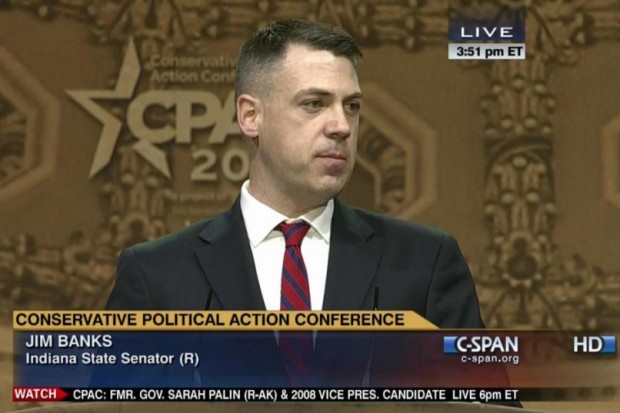Indiana Federal Lawmakers Ask DeVos To Delay Grad Rate Change

U.S. Congressman Jim Banks, a Republican Representative for Indiana’s 3rd District, is asking U.S. Education Secretary Betsy DeVos to delay changes to the high school diploma in Indiana. (C-SPAN)
Under a new federal education law thousands of Indiana diplomas known as general diplomas would no longer count for a school’s graduation rate.
As a result, Indiana could see its statewide graduation rate drop from 89 percent to 76 percent, based on 2016 data.
Now Indiana’s Congressional delegation wants the federal education department to give the state more time to prepare before that change takes effect.
U.S. Rep. Jim Banks (R-Columbia City) is the lead writer of a letter from Indiana’s bipartisan delegation asking U.S. Education Secretary Betsy DeVos for an unspecified amount of time to prepare for the change.
“This sudden and swift change in definition could have a significant negative impact on Hoosier families,” Banks said in a statement. “Indiana should be given time to adjust to the new guidance to avoid the negative economic and educational consequences associated with a sudden and steep drop in high-school graduation rates.”
Chief among those preparations – the Indiana General Assembly will need to rewrite some state policies related to high school diplomas.
Under the new federal education law, the Every Student Succeeds Act, graduation rates will now be calculated using only Core 40, Indiana’s diploma designed to prepare students for colleges or professional fields, and International Baccalaureate diplomas.
State lawmakers made completion of Core 40 a graduation requirement for all students beginning in the fall of 2007.
Jennifer McCormick, Indiana superintendent of public instruction has said the General Diploma can still be used and is still considered an official diploma.
But there are other concerns too.
A sudden change could cause some high schools to earn a lower grade in the state’s accountability plan. That means they could become eligible for state intervention.
Despite those concerns, the state is not opposing the new definition of a diploma, only its immediate implementation. Banks says current high school juniors and seniors should be allowed to complete a general diploma.
About 30 percent of students who receive general diplomas receive special education services.